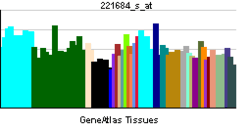Nyctalopin
Nyctalopin is a protein that in humans is encoded by the NYX gene.[3][4][5] It is a leucine-rich proteoglycan which is expressed in the eye, spleen and brain in mice.[6] Mutations in this gene cause congenital stationary night blindness in humans. A mouse strain called nob (no b-wave) carries a spontaneous mutation leading to a frameshift in this gene. These mice are used as an animal model for congenital stationary night blindness.[7]
References
- ↑ "Human PubMed Reference:".
- ↑ "Mouse PubMed Reference:".
- ↑ Bech-Hansen NT, Naylor MJ, Maybaum TA, Sparkes RL, Koop B, Birch DG, Bergen AA, Prinsen CF, Polomeno RC, Gal A, Drack AV, Musarella MA, Jacobson SG, Young RS, Weleber RG (Dec 2000). "Mutations in NYX, encoding the leucine-rich proteoglycan nyctalopin, cause X-linked complete congenital stationary night blindness". Nat Genet. 26 (3): 319–23. doi:10.1038/81619. PMID 11062471.
- ↑ Pusch CM, Zeitz C, Brandau O, Pesch K, Achatz H, Feil S, Scharfe C, Maurer J, Jacobi FK, Pinckers A, Andreasson S, Hardcastle A, Wissinger B, Berger W, Meindl A (Dec 2000). "The complete form of X-linked congenital stationary night blindness is caused by mutations in a gene encoding a leucine-rich repeat protein". Nat Genet. 26 (3): 324–7. doi:10.1038/81627. PMID 11062472.
- ↑ "Entrez Gene: NYX nyctalopin".
- ↑ Pesch K, Zeitz C, Fries JE, et al. (May 2003). "Isolation of the mouse nyctalopin gene nyx and expression studies in mouse and rat retina". Invest. Ophthalmol. Vis. Sci. 44 (5): 2260–6. doi:10.1167/iovs.02-0115. PMID 12714669.
- ↑ Pardue MT, McCall MA, LaVail MM, Gregg RG, Peachey NS (November 1998). "A naturally occurring mouse model of X-linked congenital stationary night blindness". Invest. Ophthalmol. Vis. Sci. 39 (12): 2443–9. PMID 9804152.
External links
Further reading
- Musarella MA, Weleber RG, Murphey WH, et al. (1990). "Assignment of the gene for complete X-linked congenital stationary night blindness (CSNB1) to Xp11.3.". Genomics. 5 (4): 727–37. doi:10.1016/0888-7543(89)90114-6. PMID 2574143.
- Hardcastle AJ, David-Gray ZK, Jay M, et al. (1998). "Localization of CSNBX (CSNB4) between the retinitis pigmentosa loci RP2 and RP3 on proximal Xp.". Invest. Ophthalmol. Vis. Sci. 38 (13): 2750–5. PMID 9418727.
- Jacobi FK, Andréasson S, Langrova H, et al. (2003). "Phenotypic expression of the complete type of X-linked congenital stationary night blindness in patients with different mutations in the NYX gene.". Graefes Arch. Clin. Exp. Ophthalmol. 240 (10): 822–8. doi:10.1007/s00417-002-0562-z. PMID 12397430.
- Strausberg RL, Feingold EA, Grouse LH, et al. (2003). "Generation and initial analysis of more than 15,000 full-length human and mouse cDNA sequences.". Proc. Natl. Acad. Sci. U.S.A. 99 (26): 16899–903. doi:10.1073/pnas.242603899. PMC 139241
 . PMID 12477932.
. PMID 12477932.
- Gregg RG, Mukhopadhyay S, Candille SI, et al. (2003). "Identification of the gene and the mutation responsible for the mouse nob phenotype.". Invest. Ophthalmol. Vis. Sci. 44 (1): 378–84. doi:10.1167/iovs.02-0501. PMID 12506099.
- Zito I, Allen LE, Patel RJ, et al. (2003). "Mutations in the CACNA1F and NYX genes in British CSNBX families.". Hum. Mutat. 21 (2): 169. doi:10.1002/humu.9106. PMID 12552565.
- Zeitz C, Scherthan H, Freier S, et al. (2003). "NYX (nyctalopin on chromosome X), the gene mutated in congenital stationary night blindness, encodes a cell surface protein.". Invest. Ophthalmol. Vis. Sci. 44 (10): 4184–91. doi:10.1167/iovs.03-0251. PMID 14507859.
- Khan NW, Kondo M, Hiriyanna KT, et al. (2005). "Primate Retinal Signaling Pathways: Suppressing ON-Pathway Activity in Monkey With Glutamate Analogues Mimics Human CSNB1-NYX Genetic Night Blindness.". J. Neurophysiol. 93 (1): 481–92. doi:10.1152/jn.00365.2004. PMID 15331616.
- Gerhard DS, Wagner L, Feingold EA, et al. (2004). "The status, quality, and expansion of the NIH full-length cDNA project: the Mammalian Gene Collection (MGC).". Genome Res. 14 (10B): 2121–7. doi:10.1101/gr.2596504. PMC 528928
 . PMID 15489334.
. PMID 15489334.
- Zeitz C, Minotti R, Feil S, et al. (2005). "Novel mutations in CACNA1F and NYX in Dutch families with X-linked congenital stationary night blindness.". Mol. Vis. 11: 179–83. PMID 15761389.
- Ross MT, Grafham DV, Coffey AJ, et al. (2005). "The DNA sequence of the human X chromosome.". Nature. 434 (7031): 325–37. doi:10.1038/nature03440. PMC 2665286
 . PMID 15772651.
. PMID 15772651.
- Morgans CW, Ren G, Akileswaran L (2006). "Localization of nyctalopin in the mammalian retina.". Eur. J. Neurosci. 23 (5): 1163–71. doi:10.1111/j.1460-9568.2006.04647.x. PMID 16553780.
- Xiao X, Jia X, Guo X, et al. (2006). "CSNB1 in Chinese families associated with novel mutations in NYX.". J. Hum. Genet. 51 (7): 634–40. doi:10.1007/s10038-006-0406-5. PMID 16670814.
- Zhang Q, Xiao X, Li S, et al. (2007). "Mutations in NYX of individuals with high myopia, but without night blindness.". Mol. Vis. 13: 330–6. PMC 2642916
 . PMID 17392683.
. PMID 17392683.

 . PMID 12477932.
. PMID 12477932. . PMID 15489334.
. PMID 15489334. . PMID 15772651.
. PMID 15772651. . PMID 17392683.
. PMID 17392683.